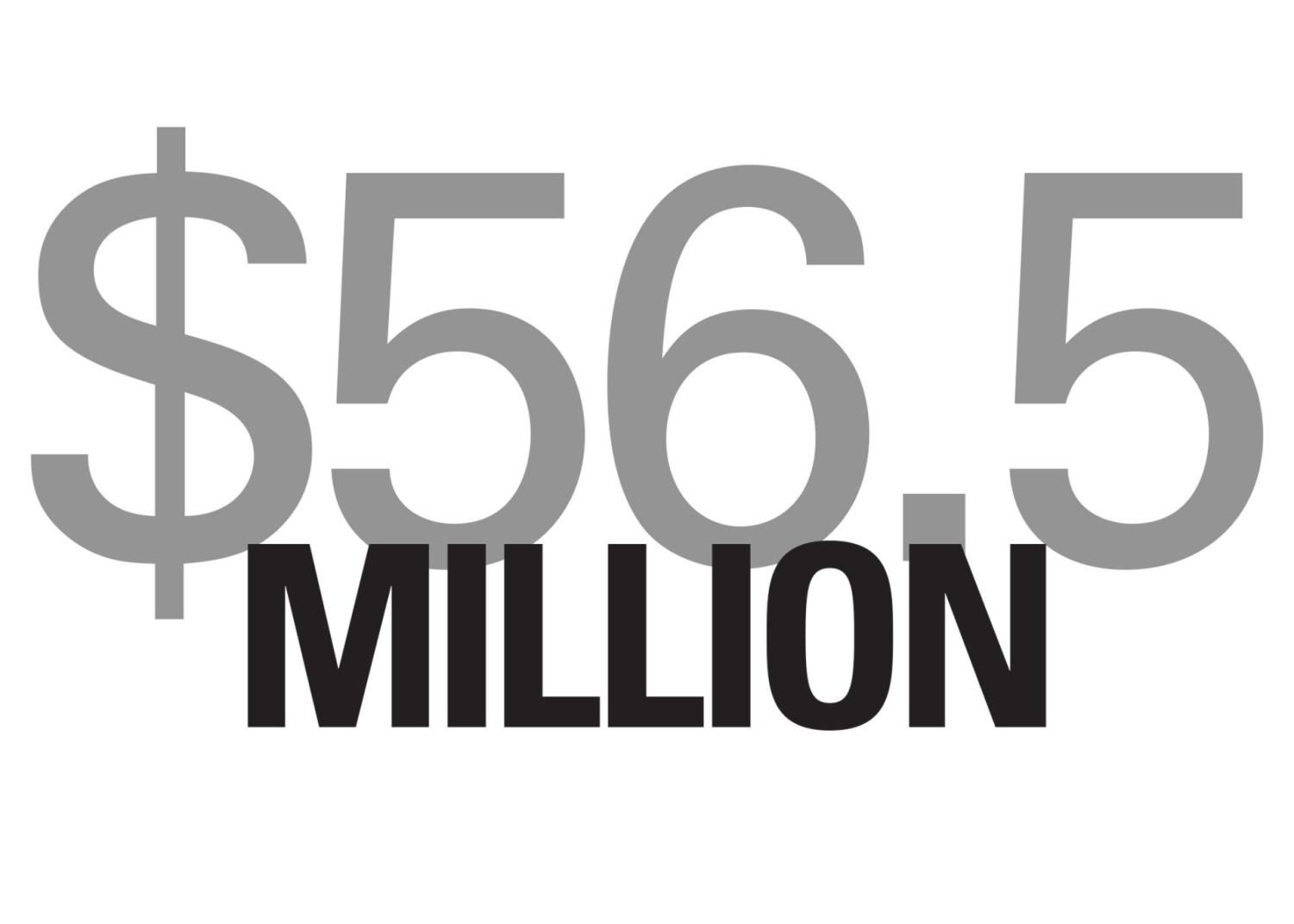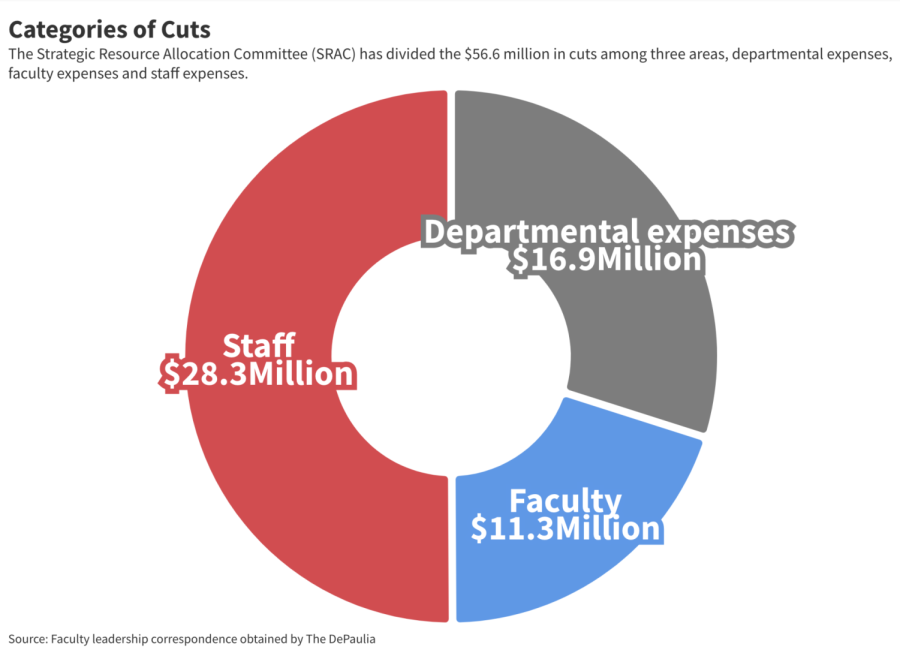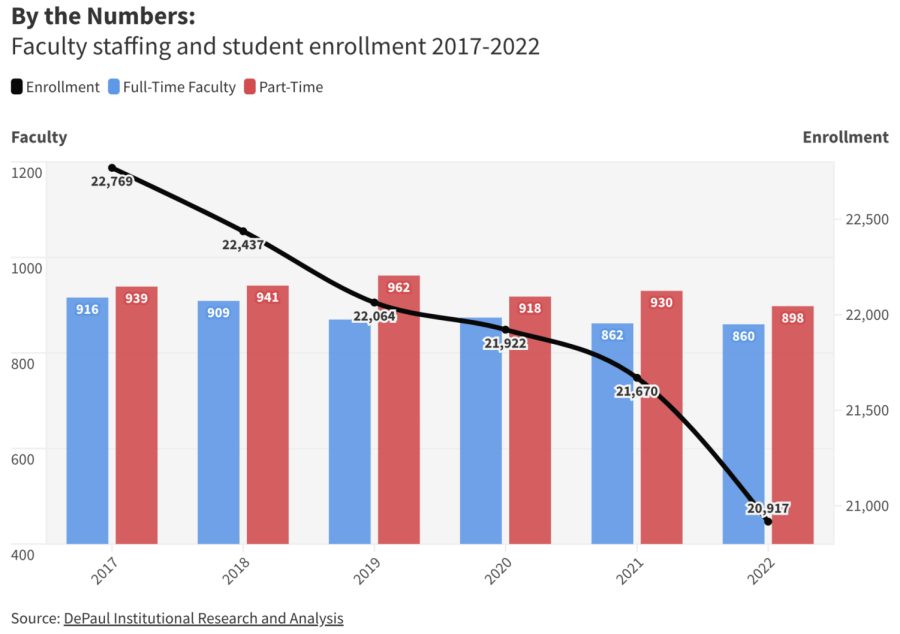Faculty: Decisions made hastily, without collaboration in effort to close DePaul’s $56.5 million gap
April 9, 2023
The first 125 days of DePaul’s 2022-23 academic year came with hope for many in its community, as the arrival of President Robert Manuel was cause for celebration after disappointment with the previous administration. But underneath, a long-developing crisis brewed.
Above it all, the new chapter brought positivity. The university commemorated beloved staff members with DePaul’s 125 faces initiative. Leaders spoke with optimism of grand plans for the future.
When the celebration ended on day 126, inside a classroom of Munroe Hall, Faculty Council members were told of an early, still evolving figure that was a first glimpse into the university’s bleak financial reality.
Over the next few months, that knowledge would grow in spurts, as faculty leaders slowly learned of more factors that affected the school’s finances over the past several years, leading to its current state.
Finally, at the beginning of the spring quarter on March 27, the scope of the situation was seen.
It was then that faculty ultimately learned the extent of a dire circumstance: that projections indicated DePaul’s expenses will outweigh revenue by $56.5 million in the 2023-24 academic year.
Decisions ‘on a dime’
“Faculty [were] lost about what’s happening,” said Marcy Dinius, a professor of English in DePaul’s college of Liberal Arts and Social Sciences (LAS). “Just fundamentally, [we] don’t understand why we went from such a rosy picture to suddenly ‘this is very dire, and we have to act immediately.’”
Typically, those tasked with DePaul’s budgeting process conduct evaluation of a following year’s budget in the school’s fall term. According to an email from Faculty Council president Sonia Soltero to council representatives, this process was pushed to the 2023 winter quarter due to more recent financial concerns centered on 2023 that demanded the Strategic Resource Allocation Committee’s (SRAC) attention. Because of the delay, SRAC’s window to evaluate the budget gap and draft strategies to close it shortened.
At the end of March, SRAC detailed the $56.5 million shortfall and informed Faculty Council representatives of where cuts would come and how much would be cut from respective areas. Cost-saving measures were broken down between faculty, who will need to cut $11.3 million; staff, who are tasked with cutting $28.3 million; and departmental expenses of which $16.9 million will need to be cut, according to the March 27 Soltero email.
Included in faculty cuts is personnel actively teaching at DePaul. Today, around 3% of DePaul’s term faculty (non-tenured, full time professors) will learn they are being cut from the university budget, according to Soltero, who told The DePaulia “most of the budget cuts around people are going to be done through vacancies,” meaning that cost saving is first directed towards not filling currently empty roles.
April 10 was the pre-decided date for decisions on term faculty contracts, and while faculty leaders had to make personnel decisions by today’s date, they didn’t know the full extent of the gap until March 27. She says $33.1 million of these cuts is coming from academic affairs, according to the only information given to faculty from the provost.
This means more than half of the total cuts for the next fiscal year will come from academic operations that includes faculty salaries, department expenses and student affairs, according to information she received from the provost.
“We can’t make decisions like these on a dime,” Dinius said. “60% of this budget cut is happening through the very part of the university that is supposed to try to make these kinds of decisions on a much longer timetable, and with much, much greater deliberation, and certainly with much more information than any of us had been given.”
With a seat at the table on SRAC, Soltero spoke to The DePaulia on the concerns felt by faculty regarding the short window and the ensuing stress surrounding tough decisions that now must be made.
“The timing constraints, we really can’t do anything about, and that’s why people are so upset because they’re right to be,” Soltero said. ‘We [on SRAC] have said that we don’t have enough time to really do a deeper analysis where the cuts should come from.”
Dinius is not the only representative on Faculty Council who feels rushed and confused. On Wednesday, April 5, Manuel joined the first hour of a Faculty Council meeting and heard faculty’s concerns on the proposed budget.
“Most of faculty expressed [to Manuel] a great deal of frustration with how this is happening,” said Winifred Curran, a professor of geography in LAS.
Curran’s college, LAS, is the largest in the university, but she says it is also one that has seen the steepest decline in tenured positions over the past decade or so.
“We have been cutting for years,” Curran said. “Functionally, we have been cutting since 2008. It’s not like there is a lot of fat left over, certainly on the faculty and student facing side.”
Like Dinius, Curran shares a concern over the lack of transparency throughout this process. She says departments are being forced to make decisions that will affect people’s lives without having all the information, like the reasoning for specific dollar amounts being cut in certain areas.
“It’s foggy, how these decisions are being made and how percentages are being decided,” Curran said. “Vulnerable people are losing their jobs when it’s not clear to us that it’s the best thing to do.”
It is unclear to faculty leaders of DePaul’s respective colleges as to exactly how many term faculty members will be affected in each department today, but communication obtained by The DePaulia indicates “colleges/schools with larger expected decreases in tuition revenue received a higher percentage target” in cuts.
As faculty like Dinius and Curran question the thought process behind the targeted areas for these impending cuts, they also question the ways in which DePaul has spent its money over the past decade. At Faculty Council meetings throughout the year, representatives have repeatedly posed the question of how DePaul got to its current financial state.
“One of the things that we’re worried about is administrative bloat,” Curran said. “That there are more and more administrative positions now, and that we are spending as much money administering the university as we are in the actual work of education.”
Administrative bloat refers to the growing number of non-instructional jobs at universities and colleges that can be linked to the continuing rise in college tuition, as defined by the Martin Center for Academic Renewal. It is just one of many factors that has put academia in the place it is now.
Dinius echoed Curran’s worry that too much of DePaul’s resources have been pointed towards administrative costs and says faculty are wondering why more cuts are not happening at the top.
“The question has repeatedly been, why is so much of this coming out of academic operations, instead of from administration?” Dinius said.
A perfect financial storm
For more than a decade, higher education in the U.S. has experienced a significant decline in enrollment. Between 2009 and 2020, annual undergraduate enrollment decreased from 17.5 million to 15.9 million students, according to the National Center for Education Statistics.
Like most other institutions, DePaul has faced an enrollment decline too. Between 2017 and 2022, DePaul’s overall enrollment dropped from 22,769 students to 20,917, per data from DePaul’s Institutional Research and Market Analysis (IRMA). While steady, the decline demanded personnel change to reflect university makeup over the same stretch.
From 2017 to 2022, full-time faculty at DePaul dropped from 916 to 860, according to IRMA data. This is a sharp decline in educators, but the 6% decrease over the period does not appear to make up for the lost tuition revenue in the six-year stretch.
Also, the 2010s saw costly building expansion on both of DePaul’s campuses.
“Bad financial decisions have been made in the past,” Curran said. “…We build new buildings, we spend a lot of money on athletics.”
Another significant ingredient for DePaul’s current financial crisis is the impact of the Covid-19.
At his State of the University address on Sept. 24, 2021, former DePaul President A. Gabriel Esteban addressed the financial hardship felt from the pandemic.
“Costs continue to rise, more students are foregoing college and public perception of the value of a college degree continues to wane,” Esteban said.
At that time, DePaul received federal funding to help relieve some of its financial woes, but by mid-July 2022, the federal relief program expired, and DePaul was back on its own.
The complicated descent towards DePaul’s current state did not happen overnight, as the factors listed above paired with rising inflation widened a gap in revenue and expenses. For a process that churned slowly, faculty and administrators must now react quickly and cut expenses that include personnel, maintenance costs, student jobs, staff and faculty travel expenses and more to make up a gap of $56.5 million.
‘A statement of values’
With the cuts that are already underway and more expected to come, certain departments feel more vulnerable than others, not just in terms of losing personnel, but also risk of losing departments themselves.
Dinius says that LAS includes several departments that represent marginalized students and marginalized topics of study, like women and gender studies, African and Black diaspora studies, LGBTQ studies and others who feel especially at risk.
“In several of those programs, you have a lot of courses taught by either part time or term faculty, and so yes, I think there’s a real danger of losing programs like that,” Dinius said.
As a fellow professor in LAS, Curran feels this proposed budget lacks appreciation for smaller departments and the educations of which students in those departments receive.
“A budget is a moral document,” Curran said. “It is a statement of your values, and this budget doesn’t value a whole lot about what we do.”
In an email to The DePaulia, DePaul Provost Salma Ghanem said that unit plans are due April 17, a week after decisions on term faculty are announced, but she is “not aware of any departments or programs that will be dissolved.”
Ghanem also addressed faculty concerns surrounding transparency and a lack of involvement throughout the process.
“The university is committed to shared governance and transparency,” Ghanem wrote. “The budget proposal was approved unanimously by the Strategic Resource Allocation Committee which includes representation from faculty, students, staff and administration.”
The provost went on to say that upon its approval, the budget was “socialized” with faculty and units.
Still, faculty feel the extended period in which they lacked full knowledge of the situation’s gravity shows a lack of interest from administrators for faculty involvement.
“Instead of allowing us to help and do the work, we were forced to pound at the doors, trying to get in to help make good decisions,” Curran said.
Perhaps the biggest concern for those who serve on Faculty Council is the abandonment of shared governance throughout the process.
Dinius explained that things move slowly at a university and for good reason. She believes sweeping institutional changes require much consideration, in which all parties — faculty governance, staff governance and administration — have a seat at the table. Dinius says what has transpired thus far goes against the system in place that ensures equitable decision making.
“This is a significant institutional reorganization through the blunt instrument of the budget,” Dinius said. “And that’s not how this is supposed to happen. It’s supposed to happen through long-term planning and shared governance.”
Thinking back to optimism felt as the academic year began, Dinius cannot help but feel disheartened with what has happened since. She said faculty have long felt a disconnect with the top end of the university in administration. Manuel’s arrival was an opportunity to rebuild that trust, but now it is hard for Dinius to not feel disappointed.
“We trusted that we had a much better partner in President Manuel, who came in with plans for growth and restoring trust between faculty and the Board of Trustees,” Dinius said. “We trusted our faculty SRAC negotiators, who helped lead the Council of the Whole.”
As faculty will lose their jobs today, the professor who is now in year 12 at DePaul, feels that any trust that was present has been betrayed by the lack of transparency throughout the process. Dinius said the events of the past few months have made trust and shared governance beyond SRAC impossible and erased some of the optimism that came with new leadership.
“All that trust has been replaced by very justified disappointment, frustration and resistance,” Dinius said.



David • Apr 20, 2023 at 10:22 am
The article would be improved by sharing what the total budget is. If it is similar to previous years (~$450m), then the gap is over 10%, which is HUGE. Also helpful would be an analysis of the endowment, and how it is being used (or not used) during these times.
However, these details aside, higher ed is in trouble. Lower birth rates > fewer HS graduates > decreasing enrollment…and that is before taking into account today’s teens coming to terms with the reality that higher ed is not the golden ticket it once was, and certainly not when coupled with life-long debt.
The faculty complain about transparency, but these are constraints anyone in higher ed should know.
Huh • Apr 13, 2023 at 10:36 pm
On transparency, this sentiment is an interesting contrast to the March article that begins with “At almost every Faculty Council meeting this academic year, one topic has dominated discussion more than any other: DePaul’s budget.”
Jack • Apr 12, 2023 at 9:12 am
This is just the beginning. The Board of Trustees at his previous institution discovered after he left how many things he hid from a financial and admissions perspective. He was extremely punitive and manipulative, pushing out administrators who expressed a different opinion.
Audrey • Apr 10, 2023 at 7:23 pm
Great article. Wish there was a tidbit about how much it costs to operate the university, pay disparities between staff and administration and how much people at the top are paid.